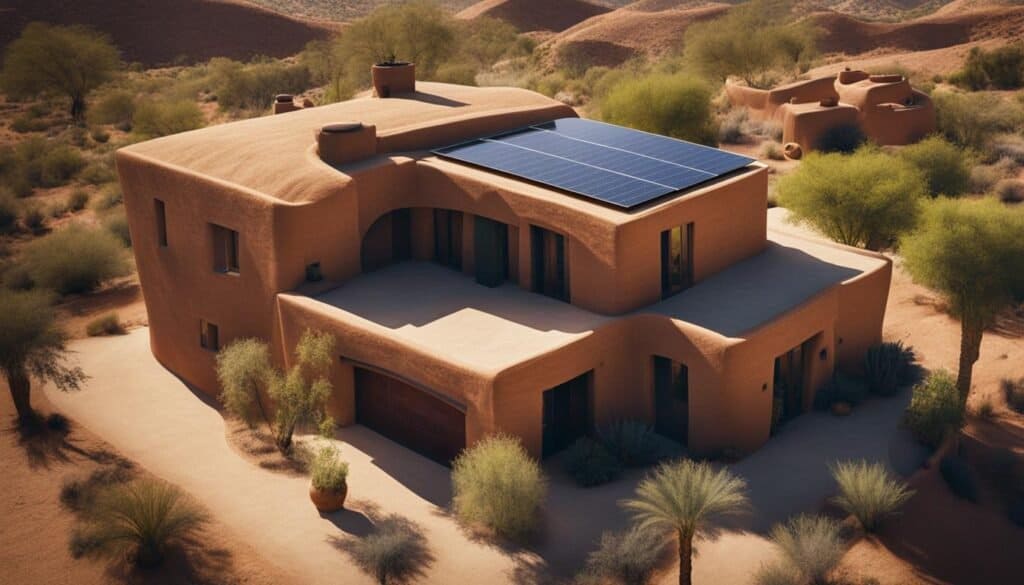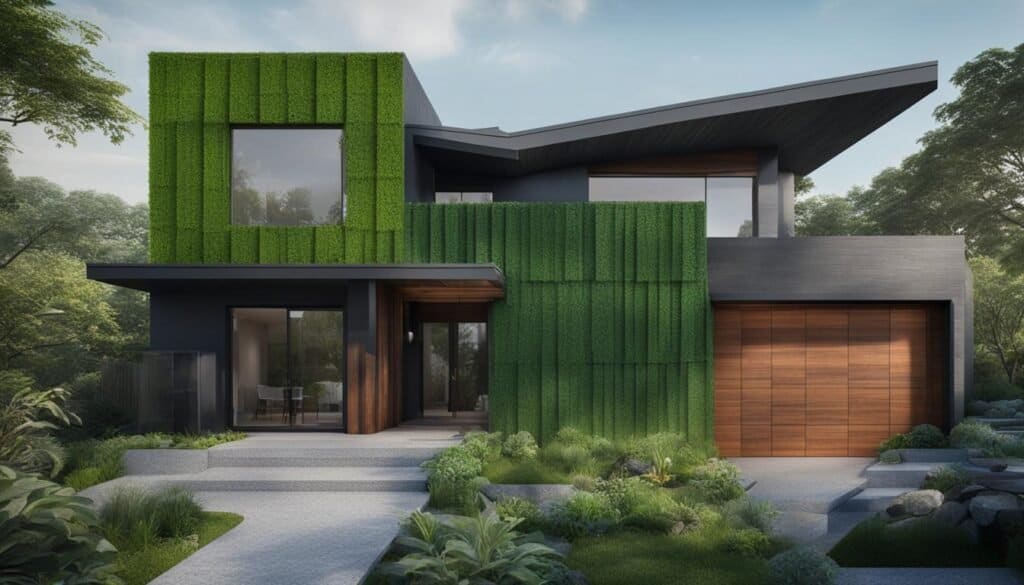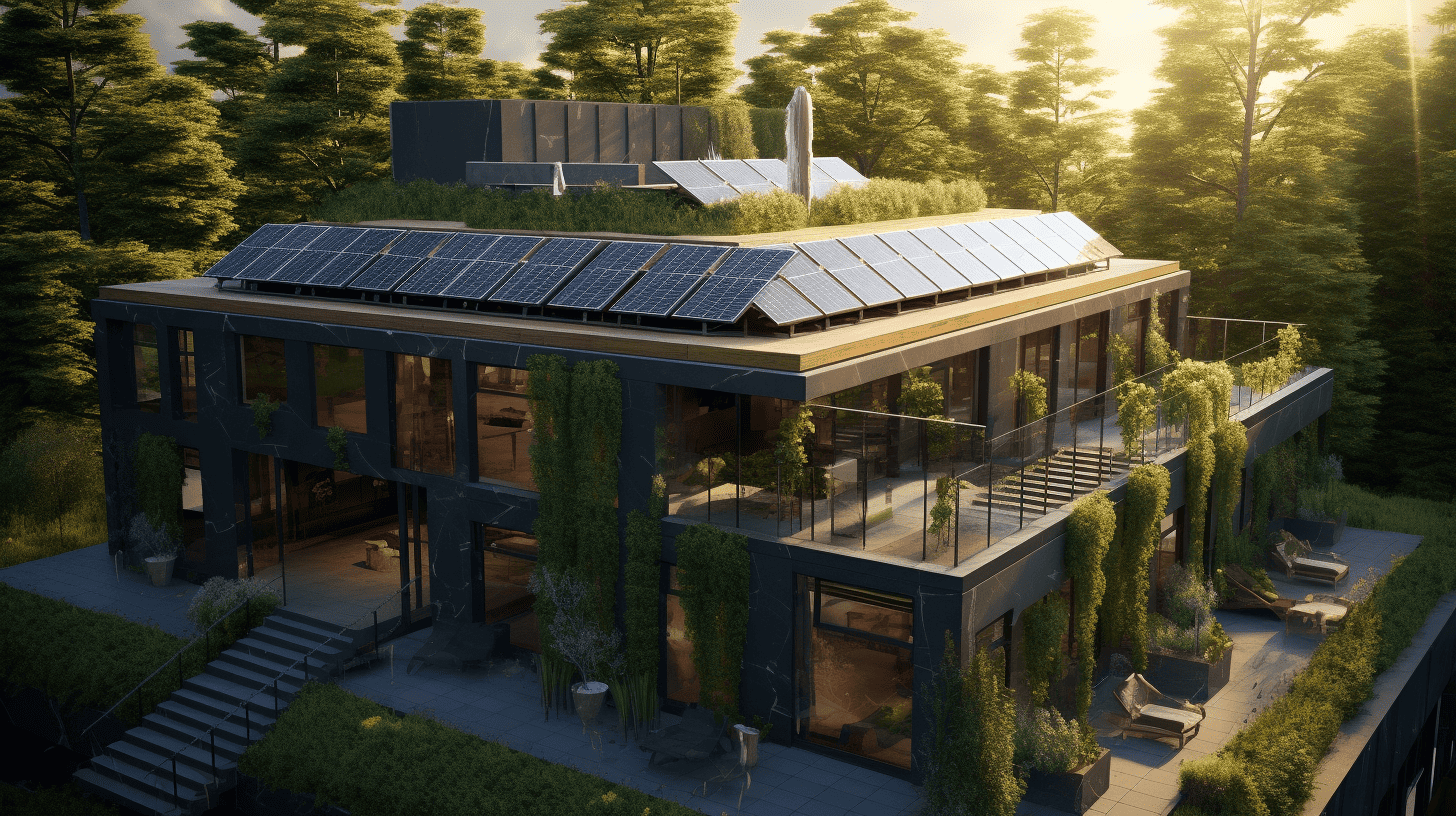There has never been a more critical time to prioritize sustainable living through the utilization of green building materials and eco-friendly construction methods. By employing long-lasting materials for sustainable living, we can create more sustainable spaces and significantly decrease our carbon footprint, propelling us towards a more environmentally-conscious future.
Key Takeaways
- Sustainable building materials contribute to both environmental protection and energy efficiency.
- Utilizing local stone varieties, such as granite and marble, can reduce transportation emissions and increase building durability.
- Reclaimed wood provides a viable solution to deforestation while offering a unique aesthetic appeal and valuable insulation properties.
- Recycled plastic lumber and other innovative plastic waste solutions are revolutionizing eco-friendly construction.
- Natural insulation materials like sheep’s wool and cellulose offer environmentally friendly alternatives for maintaining comfortable indoor temperatures.
- Hempcrete is an emerging sustainable building material with great insulation and biodegradable properties.
- Geothermal heating and cooling systems efficiently harness the Earth’s consistent temperatures to conserve energy and reduce our reliance on fossil fuels.
Top 21 Long-Lasting Materials for Sustainable Living
In pursuing sustainable living, choosing materials that are not only environmentally friendly but also durable and long-lasting is essential. This approach minimizes environmental impact and ensures that the resources we use stand the test of time, reducing the need for frequent replacements and further resource extraction. From innovative options like Hempcrete and Bamboo to traditional choices like Natural Stone and Adobe, this list of 21 long-lasting materials offers a glimpse into the array of possibilities available for those committed to building a more sustainable future:
- Cork: Renewable, biodegradable, and provides excellent insulation, harvested from cork oak trees without harming them.
- Bamboo: Rapidly renewable, strong, and versatile, suitable for flooring, furniture, and textiles.
- Recycled Steel: Reduces the need for new mining and conserves energy, ideal for structural components.
- Reclaimed Wood: Sourced from old buildings or fallen trees, reduces deforestation and adds character to homes.
- Rammed Earth: Natural, durable, and provides excellent thermal mass, ideal for walls.
- Straw Bales: Highly insulative, renewable, and biodegradable, used for constructing eco-friendly homes.
- Hempcrete: Made from hemp fibers mixed with lime and water, it’s lightweight, breathable, and has good insulation properties.
- Recycled Glass: Used in tiles and countertops, reduces landfill waste and is highly durable.
- Natural Stone: Long-lasting and requires minimal processing, suitable for flooring, walls, and countertops.
- Adobe: A traditional material made from earth and organic materials, excellent for temperature regulation.
- Terrazzo: Made with chips of marble, quartz, glass, or granite set in concrete, it’s durable and can be recycled.
- Recycled Plastic: Used in decking, fencing, and furniture, reduces plastic waste and is weather-resistant.
- Galvanized Metal Roofing: Long lifespan, recyclable, and reflects solar heat, reducing energy costs.
- Ceramic Tiles: Durable, easy to maintain, and can be made from recycled materials.
- Linen: Sourced from the flax plant, it is durable, biodegradable, and requires less water and pesticides than cotton.
- Silicone: A long-lasting alternative to plastic for kitchenware, it’s heat-resistant and non-toxic.
- Wool Insulation: Natural, renewable, and provides excellent thermal and acoustic insulation.
- Solar Panels: Durable, harness renewable energy, and reduce reliance on fossil fuels.
- Low-Emissivity (Low-E) Glass: Improves energy efficiency in homes by reflecting heat while letting light in.
- Cellulose Insulation: Made from recycled paper, it’s non-toxic and provides good thermal insulation.
- Cross-Laminated Timber (CLT): Strong and sustainable alternative to concrete and steel for building construction.
Embracing Sustainability: The Core of Eco-Friendly Construction
As the construction industry continues to evolve, adopting sustainability in construction has become a fundamental aspect of building practices. By embracing eco-friendly building practices and utilizing sustainable building products, architects and builders can create environment-conscious structures exemplifying green architecture ideals.
HereAndAfter.Eco advises investing in high-quality, long-lasting products, which not only benefits the environment but also saves money in the long run. Durable materials reduce waste and promote sustainability.
| Material | Sustainability Features |
|---|---|
| Recycled Steel | Reduces the demand for virgin steel, conserves resources, and lowers carbon emissions |
| Reclaimed Wood | Helps combat deforestation, contributes to waste reduction, and extends operational lifespan of material |
| Natural Insulation | Derived from renewable resources or recycled waste, provides excellent insulation properties, and enhances energy efficiency |
Sustainable construction minimizes environmental impact throughout a building’s lifecycle by focusing on resource efficiency and eco-consciousness. Materials such as recycled steel, reclaimed wood, and natural insulation play an integral role in achieving this objective. They provide environmentally friendly alternatives that reduce carbon footprints, conserve energy, and minimize waste generation.
“Sustainable construction seeks to create buildings that have a minimal environmental impact and reduce resource consumption over their entire lifecycle.”
One of the key benefits of eco-friendly construction is the enhancement of energy efficiency, leveraging materials and technologies that support renewable energy use, and maintain a healthy indoor environment. This approach ensures that buildings contribute positively to their surroundings rather than exacerbating resource depletion and pollution.
- Maximize energy efficiency through superior design and sustainable materials
- Reduce water consumption by implementing smart water management strategies
- Utilize renewable energy sources like solar panels and geothermal systems
- Enhance indoor environmental quality with proper insulation and non-toxic materials
By fully embracing sustainability, the construction industry can pioneer change and advance towards a greener and more responsible future. This approach requires a collective effort from architects, builders, and clients alike, each prioritizing long-lasting benefits over short-term gains
Stone: Nature’s Enduring Building Material
Stone is a remarkable building material, offering both sustainability and endurance due to its low embodied energy, durability, and natural attributes. There is an impressive range of construction uses with regional varieties such as granite, sandstone, marble, and limestone available in raw, cut shapes or slabs. By sourcing stone locally, transportation emissions can be reduced, making it a preferred choice for eco-friendly projects.
The Ancient Strength of Granite and Marble
Granite and marble are natural stones that showcase incredible strength and resilience, providing excellent durability, low maintenance, and high load-bearing capabilities. Their application versatility allows for seamless integration into various architectural styles, although skilled labor is crucial for precise installations.
“Granite durability and marble longevity make these stones superior choices for sustainable natural stone construction.”
Regional Splendor: Using Local Stone Varieties
Sourcing stone types locally reduces transportation emissions and supports the local economy. The diverse range of regional stone varieties enhances architectural splendor and offers sustainable building options through reduced environmental impact and improved material traceability.
Benefits of local stone sourcing:
- Environmentally friendly stone
- Regional building materials
- Sustainable stone sourcing
- Support for local economy
Ensuring Sustainable Sourcing of Building Stone
By adopting environmentally conscious stone procurement practices, such as responsible quarrying and fair labor conditions, a more ethical approach to construction can be achieved. This procurement approach prioritizes minimizing negative environmental impacts and fostering community development.
| Stone Type | Sustainability Considerations | Common Applications |
|---|---|---|
| Granite | Low embodied energy materials, load-bearing stone | Countertops, flooring, fireplaces |
| Marble | Stone sustainability, natural stone construction | Columns, statues, monuments |
| Sandstone | Environmentally friendly stone, local stone sourcing | Cladding, exterior decoration, landscaping |
| Limestone | Regional building materials, sustainable stone sourcing | Statuary, building facades, flooring |
Reclaimed Wood: Giving New Life to Old Timbers
Reclaimed wood is an environmentally friendly building material that breathes new life into old timbers, offering a sustainable solution to deforestation while reducing waste and prolonging operational lifespans. Reclaimed wood can be used in construction for various applications, including frameworks, flooring, and furniture.
It delivers an aged aesthetic and natural insulation properties, enhancing the ambiance of any space. However, careful sourcing is essential as reclaimed wood may contain chemicals or pests affecting both structural integrity and occupant health.
MindsetEco highlights wood as one of the oldest sustainable materials. Historically used for a wide range of items, wood is now a sustainable alternative to plastic for smaller household items.
Reclaimed wood, also known as recycled wood or sustainability harvested timber, is often sourced from old barns, factories, and other structures slated for demolition. The popularity of reclaimed wood has grown due to its unique characteristics, such as distinct markings, knots, and color variations, making it an attractive choice for homeowners, designers, and builders seeking to create an authentic, rustic atmosphere.
Sourcing sustainable timber like Forest Stewardship Council (FSC)-certified wood ensures that the reclaimed wood comes from responsibly managed forests, preserving critical ecosystems and supporting responsible forestry practices. When selecting reclaimed wood for construction, it is essential to verify the origin and treatment history to avoid introducing hazardous substances into your project.
Forest Stewardship Council (FSC) is a non-profit organization promoting responsible management of the world’s forests. FSC certifies wood that meets its strict environmental and social standards.
Aside from beautiful aesthetics and natural insulation properties, reclaimed wood offers numerous environmental benefits:
- Conserves resources by utilizing existing materials instead of harvesting new trees
- Preserves forests that provide habitat to wildlife and help regulate global climate
- Reduces waste in landfills, minimizing environmental impact
- Provides an energy-efficient construction option, reducing greenhouse gas emissions
- Supports the growth of the market for sustainable timber products
While reclaimed wood offers several advantages, it is crucial to know the potential drawbacks. For instance, this resource may be more challenging to source than traditional lumber, possibly leading to higher costs and longer project timelines. Additionally, proper treatment and removal of any harmful substances within the wood are required for safe and healthy indoor spaces.
In conclusion, reclaimed wood is an excellent choice for eco-conscious individuals seeking sustainable construction materials. With proper sourcing, reclaimed wood can contribute to resource conservation, waste reduction, and a lasting, distinctive aesthetic in any construction project.
The Ageless Charm of Adobe Brick in Modern Construction

Adobe bricks have been a popular building material for centuries, and it’s no surprise that they continue to be a sustainable option for contemporary construction. Adobe’s high thermal mass and low conductivity make them efficient at maintaining indoor temperature levels, thus reducing energy consumption and supporting eco-friendly adobe practices. Its durability and fire resistance further seal its position as an environmentally friendly construction material.
However, as with any building material, there are some considerations to keep in mind. For one, they require regular maintenance to protect against weathering in various climates. Nonetheless, the enduring charm and benefits of adobe brick sustainability make it a worthwhile choice for modern construction projects.
In ancient times, adobe bricks were widely used in constructing homes, palaces, and even entire cities, proving their long-lasting durability and timeless appeal.
One of the primary advantages of adobe bricks is their capacity to provide thermal mass in construction, meaning they can absorb and store heat during the day and slowly release it at night. This eases the load on heating and cooling systems and leads to significant energy savings, particularly in climates with significant daily temperature fluctuations.
- Adobe bricks are made from natural earth mixed with water and straw or other fibers to give the mixture added stability.
- They are shaped in molds and allowed to dry in the sun, making them low-cost and easy to produce on-site, with minimal transportation required.
- Once dried, the bricks can be used to build energy-efficient and eco-friendly structures that stand the test of time.
While adobe brick construction might be slightly more labor-intensive compared to other building materials, the end result is an aesthetically pleasing, climate-responsive, and sustainable living space that contributes positively to our planet’s future.
| Adobe Brick Properties | Benefits |
|---|---|
| High thermal mass | Efficiently maintains indoor temperature levels and reduces energy consumption |
| Low conductivity | Helps prevent heat transfer between indoors and outdoors, supporting energy efficiency |
| Eco-friendly and sustainable material | Reduced environmental impact and long-lasting durability |
| Attractive appearance | Provides a unique and visually appealing aesthetic |
All things considered, the ageless charm of adobe bricks and their sustainability make them an excellent choice for modern construction, particularly for those who prioritize energy efficiency and environmental responsibility.
Revolutionizing Recycling: Utilizing Plastic Innovatively in Buildings

Advances in recycled plastic innovation have turned plastic waste into innovative building materials, such as recycled plastic lumber. This not only mitigates plastic pollution but also provides a durable and sustainable alternative for traditional construction materials. Recycled plastic lumber, a product of innovation, has emerged as a durable and eco-friendly alternative for conventional building materials commonly used in decks, fencing, and outdoor applications.
Breaking New Ground with Recycled Plastic Lumber
Plastic lumber construction significantly contributes to sustainable plastic use and recycled plastic buildings. Plastic lumber, made primarily from recycled high-density polyethylene (HDPE) plastics, shares many similar properties to natural wood while being resistant to rot, insects, and water damage. This makes it an ideal choice for various applications, including:
- Decking and outdoor furniture
- Fencing and retaining walls
- Playgrounds and park equipment
- Marine and coastal infrastructure
Consequently, recycled plastic lumber has become one of the most sought-after innovative building materials for sustainable infrastructure projects.
From Bottles to Building Blocks: The Future of Recycled Plastics
As plastic recycling advancements continue, the potential for transforming plastic bottles into building blocks showcases the growing role of recycled plastics in the construction industry. By repurposing discarded plastic bottles, companies are creating a variety of new building materials, including bricks, panels, and insulation.
“The construction industry has the power to create positive change by adopting sustainable plastic use in their projects .”
Companies such as ByFusion and EcoDomum have developed innovative systems for processing and shaping plastic waste into construction materials. These building blocks from recycled bottles offer numerous advantages, including:
- Lower production costs compared to traditional materials
- Reduced waste generation and environmental impact
- Increased fire resistance and thermal insulation properties
- Increased durability and resistance to moisture, insects, and vermin
With these sustainable construction alternatives, we can pave the way for more eco-friendly building practices and a reduced environmental footprint.
Raising the Roof with Recycled Steel

In the pursuit of a more sustainable future, the construction industry has turned to recycled steel construction By utilizing recycled steel, builders are able to greatly reduce greenhouse gas emissions, conserve natural resources, and promote a more sustainable metal building industry.
Utilizing recycled steel in construction serves to lessen the demand for virgin steel, conserving resources, and significantly lowering carbon emissions. It provides a resilient and sustainable alternative to new steel without compromising structural integrity.
The advantages of using recycled steel in construction are numerous. Not only does it offer a more eco-friendly alternative to virgin steel, but it also exhibits exceptional strength and durability, making it an ideal choice for a variety of construction projects.
As an industry leader in steel recycling, Nucor Corporation produces high-quality steel products made from recycled sources, helping reduce overall carbon emissions and conserve valuable resources. Nucor’s commitment to sustainability is demonstrated through their participation in industry programs like the Steel Recycling Institute, a national network dedicated to promoting sustainable steel and its place in construction.
- Conserves natural resources and reduces waste generation
- Optimizes energy efficiency and lowers emissions
- Offers durability, strength, and versatility
The many benefits of steel recycling in construction can be seen across a wide range of applications such as residential housing, commercial buildings, and public infrastructure projects. As a result, recycled steel has become a popular choice for architects, designers, and builders who are looking to adopt more eco-friendly construction practices.
| Recycled Steel Attributes | Benefits in Construction |
|---|---|
| Resilience and Strength | Provides a durable building solution with minimal maintenance requirements |
| Eco-Friendliness | Reduces the demand for virgin steel and lowers greenhouse gas emissions |
| Energy Efficiency | Enhances the energy performance of buildings and supports renewable energy integration |
| Design Flexibility | Offers a variety of construction applications and lends itself well to both modern and traditional architectural styles |
By embracing the use of recycled steel in construction, the industry can work towards a more sustainable future, where eco-friendly materials play an integral role in preserving our planet’s resources and minimizing environmental impact.
The Organic Warmth of Natural Insulation

For environmentally conscious homeowners and builders, the move towards sustainable materials includes implementing natural insulation materials that deliver exceptional thermal efficiency without compromising the earth and its resources. Sheep’s wool insulation and cellulose insulation are two of the most promising and eco-friendly alternatives to traditional insulation materials, contributing to the overall reduction of building’s environmental footprint.
Sheep’s Wool Insulation: A Cozy and Sustainable Solution
Sheep’s wool insulation is gaining popularity as a renewable and eco-friendly wool insulation solution. Harvested from sheep without causing them any harm, this material offers an impressive range of sheep’s wool insulation benefits. One of the main advantages is its low thermal conductivity, which contributes to energy-saving insulation materials by efficiently reducing electric heating loads. This, in turn, promotes energy efficiency and decreases energy costs for homeowners.
Sheep’s wool insulation provides a cozy warmth while also being a sustainable choice for environmentally conscious homeowners.
Cellulose Insulation: Eco-Friendly Comfort for Your Home
Derived primarily from recycled paper products, cellulose insulation presents another viable option for environmentally friendly insulation. By repurposing waste materials, cellulose insulation advantages include superior air-tightness and thermal performance in comparison to conventional insulating materials, resulting in energy-efficient insulation for homes.
Furthermore, cellulose insulation is treated with non-toxic, fire-resistant additives, enhancing its safety and functionality within homes. Its environmentally friendly cellulose composition makes it an attractive choice for those seeking sustainable insulation solutions.
| Insulation Material | Renewability | Thermal Efficiency | Environmental Impact |
|---|---|---|---|
| Sheep’s Wool Insulation | Renewable | Low thermal conductivity | Low |
| Cellulose Insulation | Recycled | High air-tightness and thermal performance | Low |
In conclusion, both sheep’s wool insulation and cellulose insulation provide homeowners and builders with effective, sustainable, and energy-efficient options for insulating their homes and buildings. By making informed decisions about the materials used in construction projects, it’s possible to create comfortable living spaces while leaving a smaller environmental footprint.
Harnessing Hemps Potential: Building with Hempcrete
As the world searches for more sustainable and eco-friendly building materials, hempcrete construction is becoming an increasingly popular choice. This composite material consists of hemp fibers, lime, and water, offering an alternative approach to traditional building methods. Combining biodegradable and non-toxic properties, hempcrete provides an attractive, environmentally responsible solution for green construction projects.
One of the most appealing aspects of hempcrete is its superior insulation qualities. With high levels of thermal performance, it enhances energy efficiency and contributes to reduced heating and cooling costs. This makes hempcrete an eco-friendly hemp building material that benefits both the environment and homeowners alike.
Aside from insulation, hempcrete also boasts other qualities that make it an ideal choice for green construction. Made from sustainable hemp materials, its utilization supports the growth of a renewable, carbon-absorbing crop. Additionally, as a biodegradable material, hempcrete possesses a minimal environmental impact when compared to conventional building materials.
Hempcrete’s combination of biodegradability, sustainability, and energy efficiency makes it an excellent choice for environmentally conscious building projects.
Thanks to its numerous advantages over traditional building materials, hempcrete is rapidly gaining recognition and acceptance in the construction industry. As more people become aware of the need for eco-friendly building practices, it is likely that the demand for hempcrete and similar sustainable materials will continue to grow.
In conclusion, hempcrete construction provides a sustainable, energy-efficient, and eco-friendly alternative to traditional building materials. As the push for green construction continues, we can expect to see increased interest in and utilization of hempcrete and other sustainable materials that benefit both the environment and the occupants of the buildings they form.
Geothermal Heating & Cooling: Tapping into the Earth’s Power
As the pursuit for geothermal sustainability accelerates, geothermal heating and cooling systems have emerged as an indispensable solution for energy-efficient heating and cooling in buildings. Harnessing the power of renewable geothermal energy, these systems tap into the Earth’s consistent temperatures to provide climate control with minimal environmental impact.
Geothermal systems rely on a ground-source heat pump to transfer heat between the Earth and the building. During colder months, these pumps extract heat from the ground and distribute it throughout the building, providing warmth. Conversely, in warmer months, heat pumps transfer excess heat from the building back into the ground, effectively providing a cooling effect.
Geothermal heating and cooling systems not only significantly reduce our reliance on fossil fuels but also lead to low operational costs and a decrease in greenhouse gas emissions.
There are two primary types of geothermal systems:
- Horizontal Loop: In this system, pipes are laid out in trenches of approximately three to six feet deep. This type of installation is more common for residential properties due to the need for extensive land space.
- Vertical Loop: Pipes are installed vertically in boreholes up to several hundred feet deep. Vertical loop systems are well-suited for commercial properties or areas with limited land space.
| Advantages | Disadvantages |
|---|---|
| Energy-efficient, reducing energy consumption by up to 70% | Higher installation costs compared to conventional systems |
| Low operational costs and reduced need for maintenance | Requires sufficient land space for horizontal loop systems |
| Renewable energy source, diminishing dependency on fossil fuels | Site-specific considerations, such as ground conditions and regional climate |
| Decreased greenhouse gas emissions and environmental impact | Permitting and regulations may vary depending on the local jurisdiction |
Moving forward, the adoption of geothermal sustainability practices allows for energy-efficient heating and cooling in a wide array of buildings, contributing to a greener future. By capitalizing on renewable geothermal energy, we can transform the way we heat and cool our spaces—reducing our environmental footprint while maintaining effective climate control.
Conclusion on Sustainable Material
In summary, the future of sustainable living depends on the ability to embrace eco-friendly construction and utilize sustainable building materials. As seen with stone, reclaimed wood, recycled plastics, and natural insulation, these materials lower our environmental impact while offering numerous benefits in functionality, aesthetics, and durability. A strong emphasis on sustainable construction can bring about a significant collective impact, leading to a greener future for everyone.
Moreover, by focusing on the environmental benefits of eco-materials, architects, designers, and builders create structures that conserve energy and resources, reducing our carbon footprint and contributing to a healthier planet. Incorporating renewables such as geothermal heating and cooling systems adds another layer of sustainability, further alleviating our reliance on harmful fossil fuels and nonrenewable resources.
Ultimately, the green building movement shows immense promise in helping preserve our environment for future generations. By raising awareness and implementing sustainable construction practices, we are collectively working towards a future where eco-friendly and sustainable living is more accessible for everyone. So, let’s continue pioneering innovations and driving positive change in the world of construction.
FAQ on Long-lasting Materials for Sustainable Living
Q: What is a green building and why is it important?
A: A green building, or a green home, refers to a structure that is environmentally responsible and resource-efficient throughout its life cycle. This can mean using sustainable products, energy-efficient designs, and materials that have a minimal impact on the environment. They are important as they significantly reduce the carbon footprint and energy bills, pushing towards sustainability.
Q: What is a green building material?
A: A green building material is a type of construction material that’s sourced and manufactured in a way that makes the material more sustainable than conventional materials. It includes materials that have been recycled, repurposed, or sourced from renewable sources. Examples of green materials include cork, bamboo, and recycled materials.
Q: What benefits does bamboo offer as a green building material?
A: Bamboo is one of the most sustainable construction materials in the world. It’s a renewable material that grows much faster than traditional woods, making it a perfect material for green home building. It can be used for walls and building, flooring, and a variety of other applications in home construction.
Q: How does cork contribute to green building construction?
A: Cork is a sustainable product largely due to the way it’s harvested. It comes from the bark of cork oak trees, which can be stripped without killing the tree, making it a renewable resource. It’s commonly employed in green home construction for flooring and insulation purposes.
Q: How is the environmental impact of a building material assessed?
A: The environmental impact of any building material is assessed throughout its life cycle – from extraction or sourcing, manufacturing, transportation, use, and eventual disposal or reuse. Elements considered during this assessment include its impact on the environment, its energy-efficiency, and its potential for reuse or recycling.
Q: What is the importance of using recycled materials in green building?
A: Using recycled materials in green building not only reduces waste on the construction site but also minimizes the impact on the environment by reducing the need for new materials. This makes the building a home process more sustainable.
Q: How does green building contribute to sustainable living?
A: Green building significantly contributes to sustainable living by reducing the environmental impact. It promotes the efficient use of resources, reducing both waste and energy bills. The use of sustainable materials and energy-efficient designs make a green home far more sustainable than a conventional home, creating a healthier living environment.
Q: What makes a material more sustainable than others?
A: Various factors make some materials more sustainable than others. This includes the material’s life cycle, its mode of production, its durability, and its potential for reuse or recycling. Renewable materials such as bamboo and cork are often considered more sustainable due to their fast growth and low impact on the environment.
Q: How is green building better than traditional construction methods?
A: Green building is more beneficial than traditional construction methods for several reasons. From an environmental standpoint, it reduces waste and promotes the use of sustainable and recycled materials. Additionally, green homes are often more energy-efficient, leading to lower energy bills and a smaller carbon footprint, which contributes to sustainability.
Q: What are the best eco-friendly building materials for a sustainable home?
A: The best Eco-friendly building materials for a sustainable home include bamboo, cork, recycled steel, and reclaimed wood. These materials are renewable, recyclable, and have a lower environmental impact compared to traditional construction materials. They play a vital role in building a green home that is both sustainable and efficient.





Leave a Reply